My latest bout of all-nighters turning sodas into source code took a delightfully unusual form. I built a small web application… for audience use… during a live theatre production… for a high school. To unpack:
Since 2009, I have returned each fall as an alumni/guest artist to do graphic design for St. Andrew’s Episcopal School’s high school musical. The show is still directed by Rick Garcia, who was also my director as a student. This year’s show is Spring Awakening and Rick is up to his usual tricks of incorporating unexpected elements to educational (and “how the hell are we gonna pull this one off?”) effect.
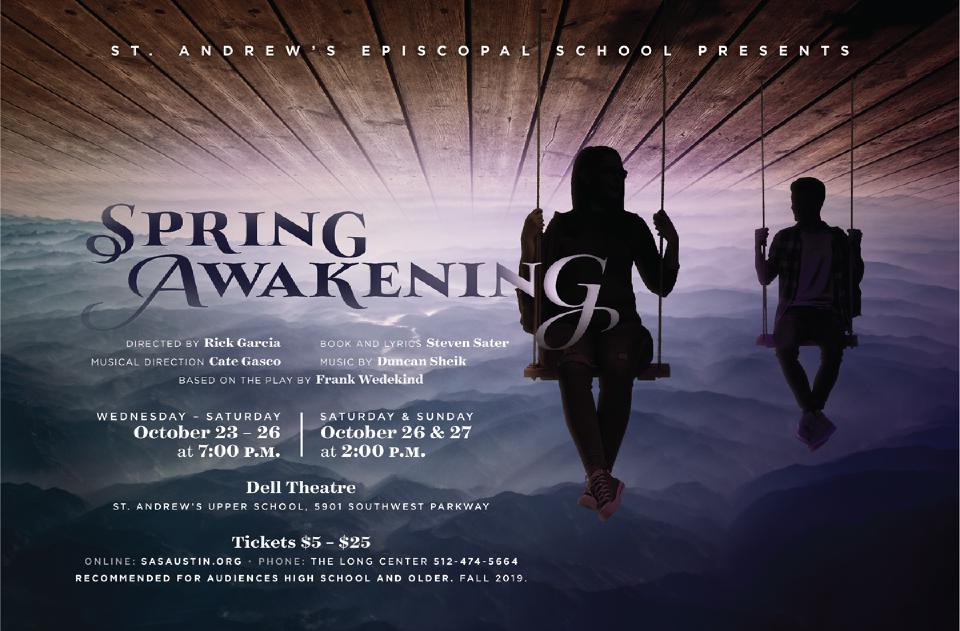
Theatre of the Oppressed
Theatrical artist Auguto Boal began experimenting with “Theatre of the Oppressed” mechanisms in Brazil in the 70s. In his “forum theatre” exercises, actors or audience members could pause a performance and discuss the character’s situation and work out a better choice. Other exercises took different forms, but the goal of Boal’s work was the promotion of social change through deeper audience engagement. Rick wanted to include these kinds of concepts in the production.
Spring Awakening
This show is challenging. It confronts incredibly intense issues, potentially even more jarring for parents than for their students. When I talk to colleagues about working a high school production of Spring Awakening, I hear a lot of, “oh wow, that’s a pretty adult show for kids!”
Respectfully — though I certainly cannot speak from the perspective of a parent — I question the thinking behind that statement. This show is written about high schoolers, set in high school. This is a high school cast. And though the musical was created in 2006, it is based on a German play written in 1891. So not only are these issues timely for a cast this age, they are also not new. Perhaps what we mean is that these issues are uncomfortable to talk about. But by not talking about them, our community can slip into thinking “well that’s not an issue for us; that’s something over there.”
And yet, a friend of mine who does advocacy work in Tulsa (my second home) shared this on Facebook yesterday, from the Oklahoma Maternal and Child Health Service:

One theme of this show is the need for honest, truthful conversations between adults and “coming of age” adolescents. One factual conversation about “where babies come from” would have collapsed the central plotline.
Here’s where Rick enters Theatre of the Oppressed. We are not going to re-write Spring Awakening on the fly. Instead, he envisions a way we can help prove its point. What if, around poignant scenes with important messages, we can push the audience toward the realization that this content is relevant — to all of us, right here.
Audience Awakening: The Use Case
His premise is simple. He wants to poll the audience during scene transitions. Display a question on the projector, a narrator reads it, audience members vote using their phones, and the results are displayed: both how people voted — how they perceive the issue — and the correct answer from statistical data about the truth of the issue.
(For my gamer friends out there, transactionally speaking: he’s describing JackBox.)
I hashed out a flow diagram.
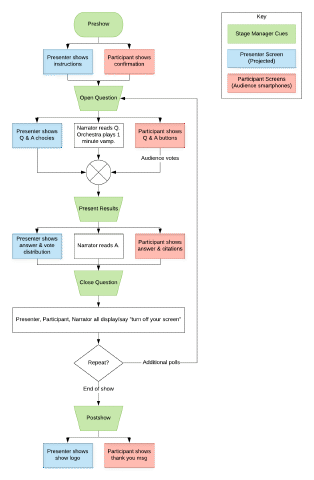
An aside: the appropriateness of audience smartphone use is another major ongoing discussion in the industry. And I love the imagery here: the stereotype of teenagers ignoring their parents by being immersed in their phones juxtaposed against actually encouraging parents to whip out their phones during a play. Potentially losing some of them to distracting notifications during scenes they’d rather ignore?
A sample scenario:
- (MINOR SHOW SPOILER) In the show, Martha is physically abused by her father, which she hides from her friends but accidentally reveals. She begs them not to tell anyone because she doesn’t want to “end up like Ilse,” whose parents kicked her out of the house.
- As the scene ends, the projector illuminates:
- True or False: In 2018, Child Protective Service removed over 16,000 Texas children from their homes as a result of abuse or neglect.
- Audience votes. Votes are tabulated silently on the next screen. Then the answer:
- True. In 2018, CPS removed 16,221 children as a result of abuse or neglect.
Product Requirements
As seen in the flow diagram, the concepts aren’t complicated. However, our artistic team had specific requirements. We could not find an existing product to use because:
- We wanted to customize the look of all displays.
- Traffic had to be lightweight enough to avoid network congestion preventing people from participating.
- From my professional experience, I know that users are disinclined to go download an app from their app stores without a significant return on that investment.
- The user experience needed to feel welcoming and streamlined enough that an age-diverse audience would actually participate through multiple rounds.
- The results needed to be displayable on the theatrical projector (via qLab or Isadora integration) and/or unattended computer treating the projector as a monitor.
- The stage manager needed to be able to control every transition of the application easily, potentially jump out of order.
Audience Awakening: The Web App
In 2013, I built a little game as an experiment in “I wonder what this ‘Node’ thing is.” It used Express and Socket.io on Node 0.10. That pattern is rudimentary compared to today’s more popular frameworks, but those tools are still maintained and much more mature now. And again, this was ultimately a simple application. For lack of time, I started there and tried to write cleaner code this time, even if a lot of the frontend still boils down to direct DOM manipulation. I got a prototype working in just a couple of hours.
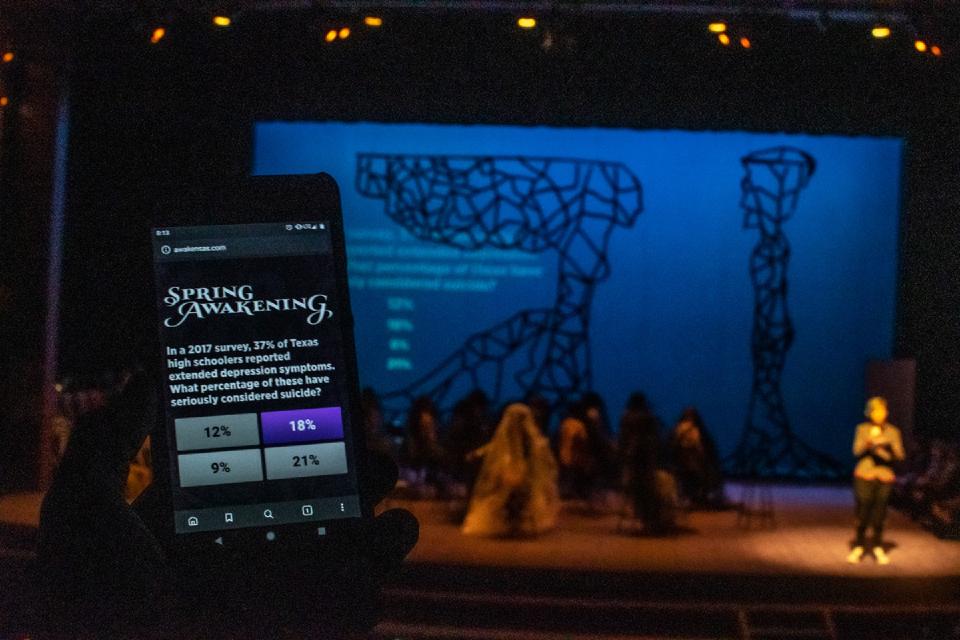
I spent the next week making functional adjustments in conjunction with the student stage manager and student assistant director. I also matched the application’s simple theming to my publicity graphics, the scenic designer’s vision, the lighting designer’s use of the cyc (a white backdrop that doubled as the projection surface), and the limitations of how the projector was configured.
Audience Awakening code repo on GitHub
Supported “Personas”
As implied in the flow diagram, the application serves three types of clients, each with their own display, plus an additional display for testing.
Participants: A very simple mobile-optimized display that shows the show logo, basic instructions, questions, buttons for voting, answers for the audience, and design elements from the set.
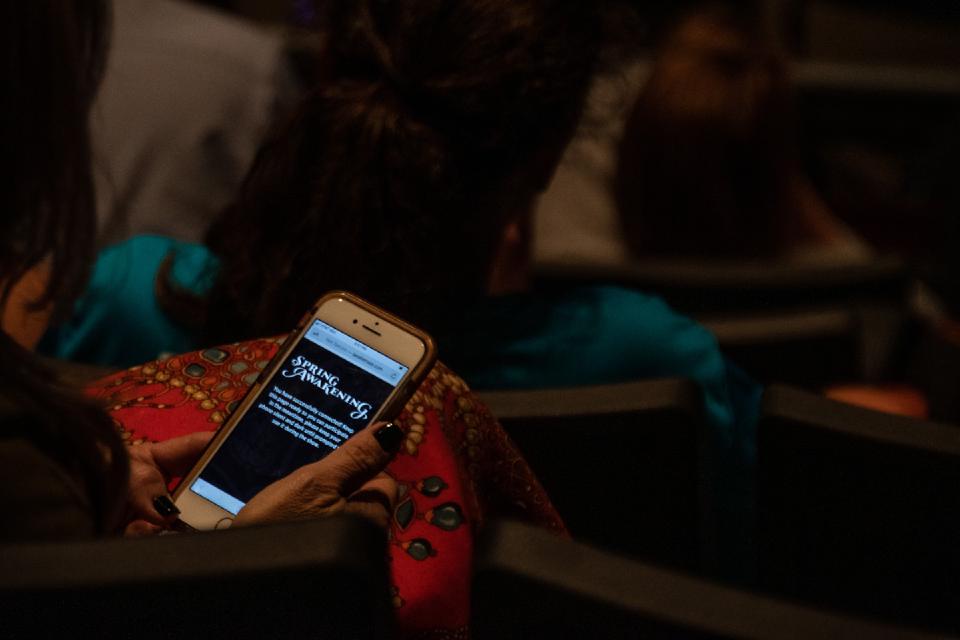
Presenters: The read-only/unattended display used on the projector. It shows questions, answers, and the distribution of the results.
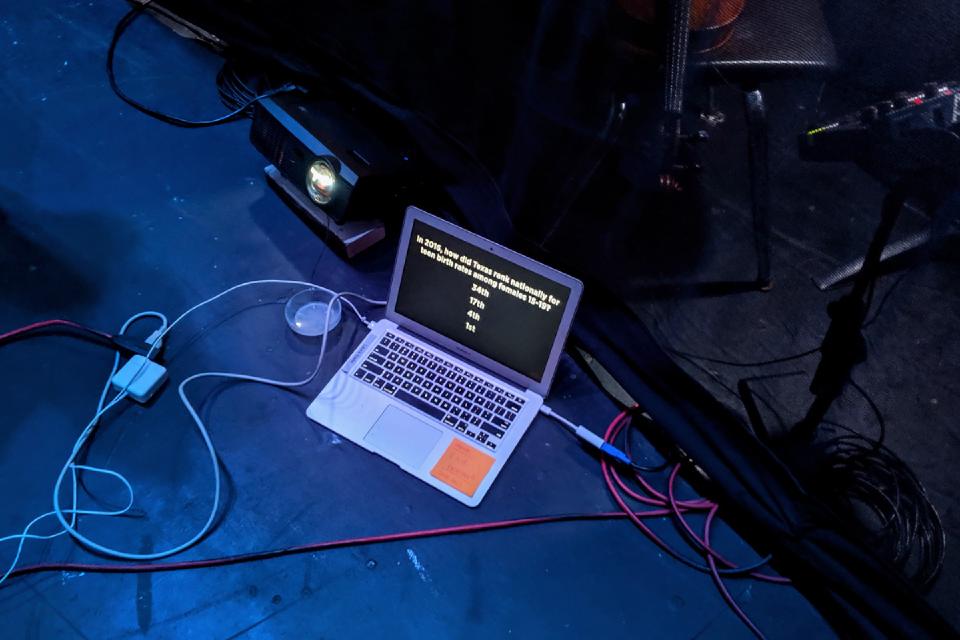
We had every intention of using the primary long-throw projector from the booth, but given how the scenic design worked, putting this in the passthrough behind the orchestra was surprisingly better. And it looks ridiculous, very theatre.
Admins: This is the stage manager’s console to advance through the stages of the application.
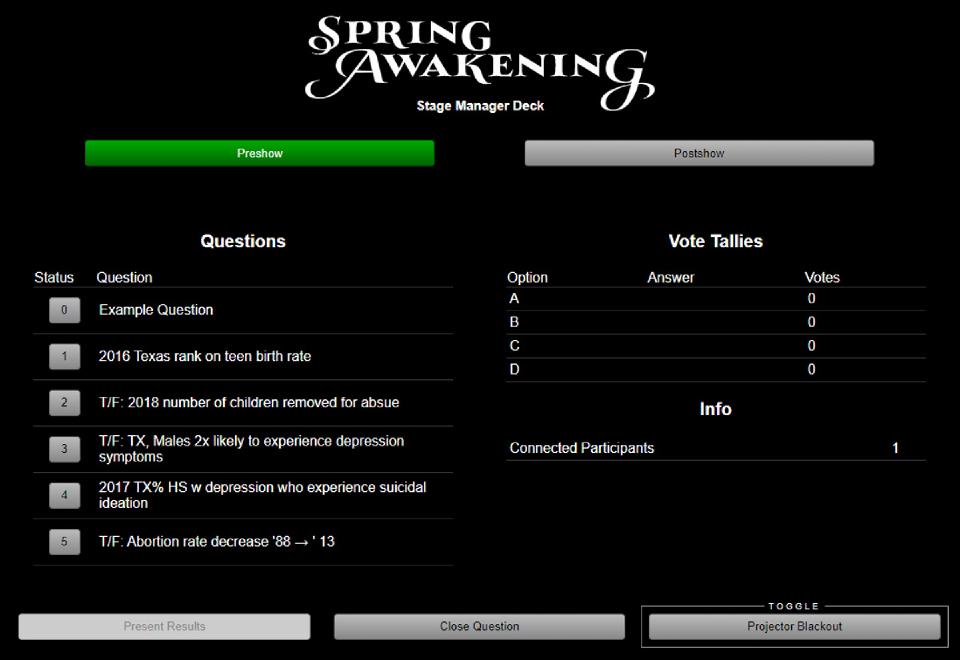
Debuggers: A testing mode just for me. It shows the three other displays side-by-side and buttons to force an all-client reload, pull a game state data-dump, or add votes for testing. And because all Admin interactions run through Socket, I can watch the SM manipulate the system from this screen while it happens — his display syncs up with this.
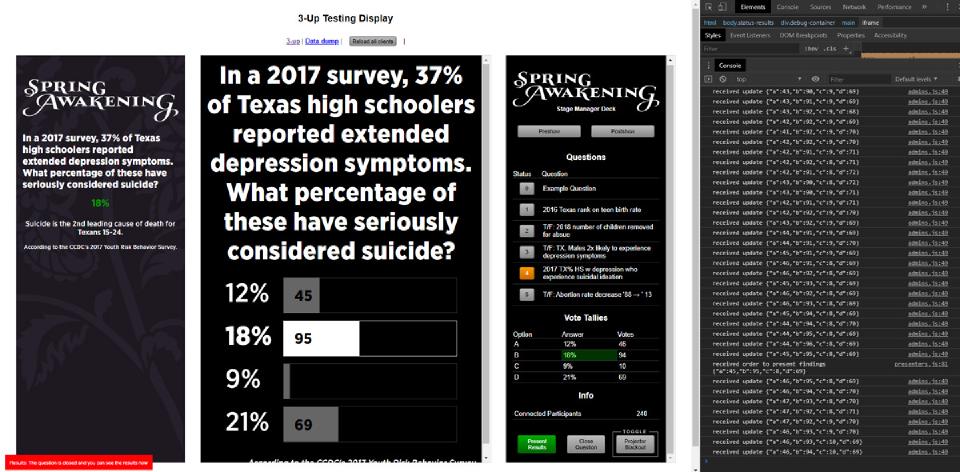
The 250 connections demo shown here was during an impromptu demo in an all-school assembly. Rick gave me five minutes’ notice on that one. But it worked! 🎉
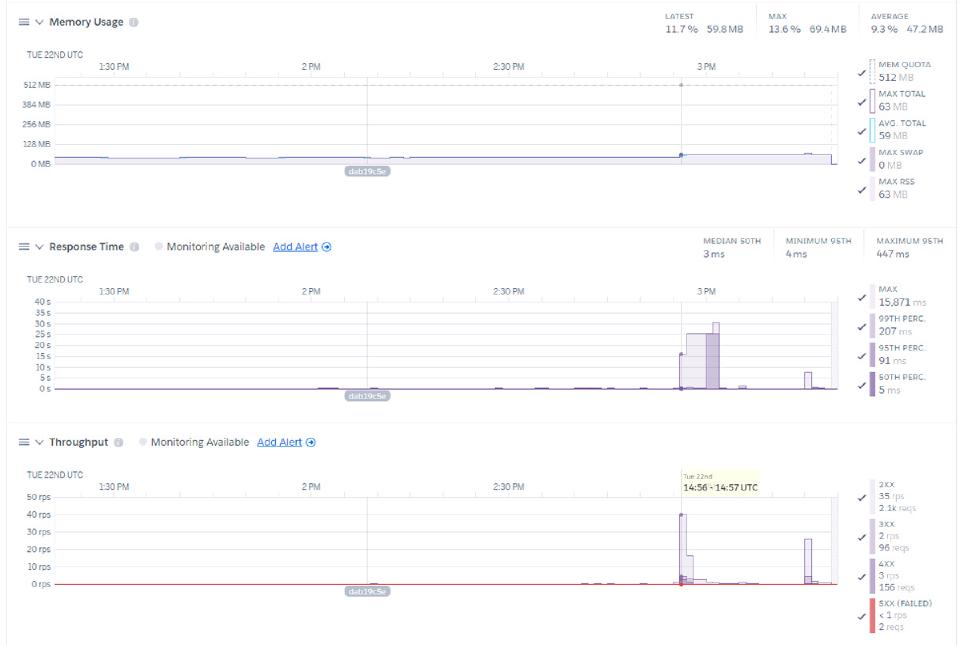
As anticipated, Heroku’s metrics dashboard confirmed that even the smallest Standard Dyno was well beyond what I needed. Which is to say: yes, it’s hosted on Heroku with automatic deploys from GitHub. That and the debugger’s reload button made it easy to update code live during rehearsals and push application updates to other consoles.
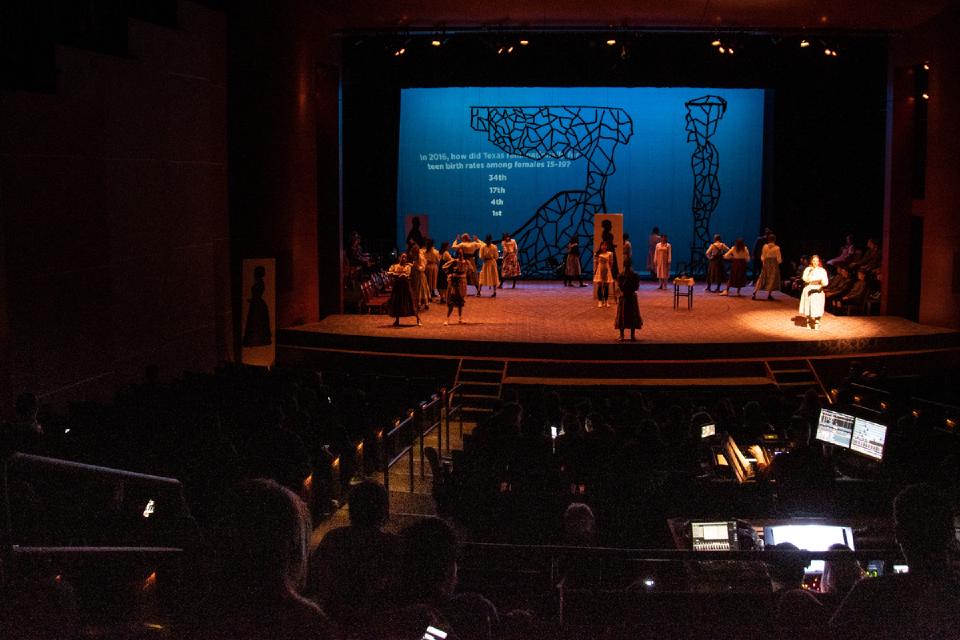
Preview night / open final dress rehearsal. A few audience members are voting.
I always love the opportunity to find new intersections for all my hobbies. The magic of creating theatre comes out in labors of love, long nights, and taking things you know and applying them in new ways every time. This was a simple technical and design execution — this application only serves to help reinforce a point that the show creates, but I like its place in the message. I’m super grateful for yet another journey with the SAS team through a great show.
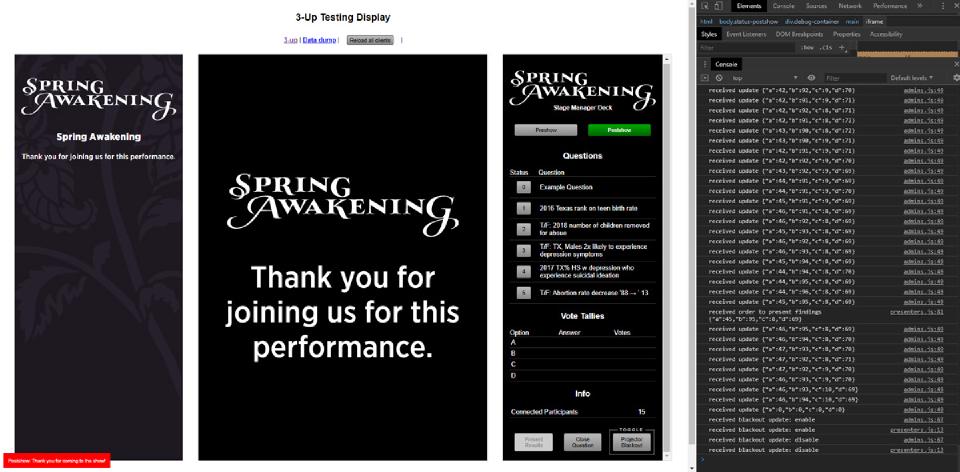
Spring Awakening was performed with special permission from Music Theatre International.